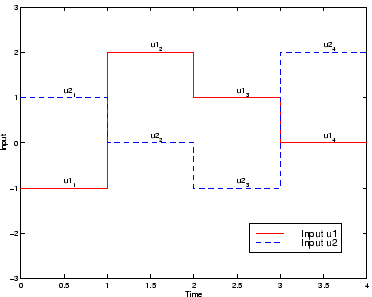Syntax createLBobjects(nGen,sLen);
Description
This function creates the symbolic variables representing the Lie
algebra generators and the control inputs. The function assumes the
variables do not exist, so if the variables exists, they will be
replaced by the new ones, with the corresponding assumptions without
warning to the user. Adding a line to check for the existence of
already assigned variables is simple and can be done as for the
function phb. In general, however, verifying variables
redefinition should not be really necessary since the amount of
variables regarding a particular problem or system is directly related
to the system model, which should only be changed at the time of
declaring the system generators and inputs and not at some
intermediate step of the symbolic manipulations.
|
Arguments

Examples
Declaration of vector fields for a system with drift, 2 inputs and a
sequence of control inputs of length 4 (i.e. four switches).
> createLBobjects(3,4); Generators Input Sequences f0~ u0_1~ u0_2~ u0_3~ u0_4~ f1~ u1_1~ u1_2~ u1_3~ u1_4~ f2~ u2_1~ u2_2~ u2_3~ u2_4~ Span of Generators for each segment of the control sequence f_1:=f0*u0_1+f1*u1_1+f2*u2_1 f_2:=f0*u0_2+f1*u1_2+f2*u2_2 f_3:=f0*u0_3+f1*u1_3+f2*u2_3 f_4:=f0*u0_4+f1*u1_4+f2*u2_4 |
Discussion
In the above example, f0, f1, f2 represent the vector fields
which generate the Lie algebra. The tilde ~ symbol at the end
of each variable indicates that some assumptions have been made on
these variables. The ``subindex'' _i, after each variable
var indicates the corresponding time interval,
thus the expression var_i corresponds to the particular
value of var in the time interval i of the input
sequence. An arbitrary input sequence with 4 switches is illustrated
in Fig. 6.1.
|
